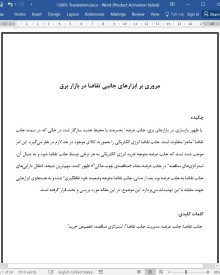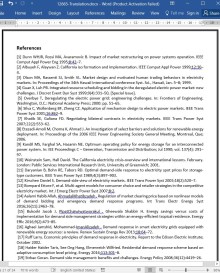
دانلود مقاله مروری بر ابزارهای جانبی تقاضا در بازار برق
چکیده
با ظهور بازسازی در بازارهای برق، جانب عرضه بهسرعت با محیط جدید سازگار شد، در حالی که در سمت جانب تقاضا ماجرا متفاوت است. جانب تقاضا انرژی الکتریکی را بهصورت کالای موجود در حد لازم در نظر میگیرد. این امر موجب شده است که جانب عرضه متوجهِ خرید انرژی الکتریکی به هر نرخی توسط جانب تقاضا شود و به دنبال آن، استراتژیهای مناقصه در جانب عرضه، بهنام «مناقصهی چوب هاکی » ظهور کنند. مهمترین نتیجه، انتقال داراییهای جانب تقاضا به جانب عرضه بود. بعد از مدتی، جانب تقاضا متوجه وضعیت خود غافلگیری شده و به جستجوی ابزارهایی جهت مقابله با این تهدیدات میپردازد. این موضوع، در این مقاله مورد بررسی و بحث قرار گرفته است.
1. مقدمه
تا چند دهه قبل، مسئولیت مدیریت و کنترل سیستم قدرت بر عهدهی دولت بوده و بهندرت بخش خصوصی نقشی در آن داشت. این ساختار انحصاری سیستم قدرت ناکارآمد بوده و منافع تولیدکنندگان تامین نمیشد. راهحل این مسئله، خصوصیسازی و بازسازی سیستم قدرت بود که بازار رقابتی را در سطوح تولید، انتقال و توزیع فراهم کرد. بهطور کلی و بعد از خصوصیسازی، صنعت برق به دو بخش تقسیم شد:
• بخش عمدهفروشی
• بخش خردهفروشی
بخش عمدهفروشی شامل شرکتهای تولیدکنندهای است که در حجم بالا انرژی الکتریکی تولید کرده و از طریق خطوط انتقال ولتاژ بالا به مراکز بار منتقل میکنند. در گام بعدی، شرکتهای خردهفروش به نمایندگی از جانب تقاضا، گاه مصرفکنندههای بزرگ، انرژی مورد نیاز خود را مستقلاً خریداری میکنند [1-8].
در بازار برق کنترل نشده، تا همین اواخر، تنها شرکتهای تولیدکننده در بخش عمدهفروشی با یکدیگر در فروش برق به مصرفکننده و با هدف افزایش سودشان رقابت میکردند و جانب تقاضا نقشی در این زمینه نداشت. به بیان دیگر، جانب تقاضا انرژی الکتریکی را بهصورت کالای موجود در حد لازم در نظر میگیرد که بیانگر انعطافناپذیری آن است. بهطور کلی، جانب تقاضا به محیط جدید وفق داده نشده بود. این ناسازگاری جانب تقاضا، باعث افزایش حرص و طمع مهندسی شرکتها شده و سریع متوجه شدند که جانب تقاضا حاضر به خرید برق به هر نرخی است که این امر منجر به ظهور استراتژیهای مناقصه در جانب عرضه شد که با نام «مناقصه چوب هاکی» شناخته میشود [9].
5. نتیجهگیری
با ظهور بازارهای برق تنظیم نشده، زمانی که جانب تقاضا در حال وفق دادن خود و سازگاری با محیط جدید بود، جانب عرضه بر بازار حاکم و با ارائهی استراتژیهای مناقصه، داراییهای جانب تقاضا تسخیر شد. این روند تا سالهای اخیر و تا زمان کشف راهحل جانب تقاضا ادامه یافت.
در بازارهای برق مبتنی بر خزانهی الکتریکی، مشکل اصلی انعطافپذیری کمتر جانب تقاضا در مقایسه با جانب عرضه است. از آنجایی که اکثر شرکتهای تولیدکننده برای تاثیرگذاری بر نرخها با عواقب کمتر، میتوانند میزان تولید خود را تغییر دهند، جانب تقاضا انعطافپذیری کمتری در کاهش مصرف جهت ایجاد منحنیهای مناقصه دارد. یکی از استراتژیهای مناسب برای افزایش انعطافپذیری جانب تقاضا، استفاده از برنامههای DSM است. پیشنهاد میشود که محققان مطالعات خود را از زمینهی استراتژیهای بهینهسازی به سمت تحقیق و استخراج منحنیهای مناقصه با پیادهسازی مبحث DSM سوق دهند؛ مثلاً خردهفروشانی را در نظر بگیرند که به شرکت در برنامههای DSM علاقهمند هستند. پاسخ مشتریان منجر به افزایش انعطافپذیری خردهفروشان بیش از گذشته میشود. در حقیقت، خردهفروشان مجهز شده و با در نظر گرفتن استراتژیهای مناقصهی مناسب، میتوانند بر نرخها جهت افزایش سود خود تاثیر بگذارند. چندین پژوهش در این زمینه انجام شده اما همچنان نیازمند تلاش و مطالعهی بیشتر است.
از طرف دیگر، خردهفروشان و مصرفکنندگان بزرگ برای کاهش خطر خود، میتوانند نیازهای خود را از منابع مختلف برق مانند بازارهای دوجانبه، تولید خودی و برق خزانه تامین کنند. استفاده از هر یک از این منابع، دارای مزایا و معایب منحصر بهفردی بوده و نیازمند مطالعات جامع است.
Abstract
With the advent of restructuring in the electricity markets, the Supply-side quickly adapted to the new environment, whereas, the story in the demand side has been different. Demand side dealt with the electric energy as a commodity available to the necessary extent. This caused the Supply-side to realize that the demand side would admit to purchase electric energy at any price, and this resulted in the advent of bidding strategies in the Supply-Side, known as “hockey-stick bidding”. The most important result was transfer of the demand side assets to the Supply-side. After a while, the demand side noticed the self-sloppy condition, therefore looked for tools to deal with these threats. This subject is examined in this paper.
1. Introduction
Until a few decades ago, the government was responsible for management and control of the electric power system and it was rarely owned by the private sector. This exclusive structure of the power system was inefficient and did not ensure the benefits of producers. Solution for this problem was privatization and restructuring of the power system, which provided a competitive market at the levels of generation, transmission and distribution. In general, the electricity power industry, after privatization, was split into two parts:
• The Wholesale Sector
• The Retail Sector
The wholesale sector is comprised of the generation companies, which generate electric energy in high volume and transmit it to the load centers throw high-voltage transmission lines. In the next step, the retailer companies, on behalf of the Demand-side and, occasionally Big Consumers, purchase their required energy independently [1–8]. In Deregulated Electricity Market, until recently, only the generation companies in the wholesale sector would seek to compete with each other to sell their electric energy to customers with the objective of increasing their profit, yet the Demand-side had no function in this respect. In the other words, the Demand-side dealt with electric energy as a commodity is available to the required extent, which indicates its inflexibility. Overall, the Demand-side had not been adapted to the new environment. This incompatibility of the Demand-side caused the increasing greed ingeneration companies and soon it was realized that the Demand-side would yield to any price to purchase electric energy, resulting in the advent of bidding strategies in the Supply-Side, known as “hockey-stick bidding” [9].
5. Conclusion
With the advent of deregulated electricity markets, when the Demand-side stretched and bended in compliance with the new environment, it was the supply side that ruled the market and by offering the bidding strategies, the Demand-side asset was captured. This process continued until recently when the Demand-side also sensed and sought a solution.
In the context of electricity markets based on the electricity pool, the main problem is the lower flexibility of Demand-side compared to the supply side. Since most of generation companies can change their rate of production, with less consequences, in order for affecting the prices, yet the Demand-side has less flexibility in consumption reduction for the construction of bidding curves. One of the suitable strategies for the expansion of the demand-side flexibility is to utilize DSM programs. It is suggested that researchers surge their studies in the context of optimization strategies towards the investigation and derivation of bidding curves by implementing DSM discussion; i.e., consider a retailer whose some customers have enthusiasm to participate in DSM programs. The response of customers leads to expansion of flexibility of retailer more than before. In fact, the retailer becomes equipped and can affect on the price, in favor of his benefit, by considering suitable bidding strategies. In this context, a few works have been done, yet they are not considerable and require more attempts.
On the other hand, retailers and big consumers can, for the reduction of their risk, cater their needs from different sources of electricity such as bilateral markets, self-productions and electricity pool. Using each of these sources has its own cons and pros which requires comprehensive studies.
چکیده
1. مقدمه
2. مدیریت جانب تقاضا
3. تخصیص خرید
4. استراتژی مناقصه
5. نتیجهگیری
منابع
ABSTRACT
1. Introduction
2. Demand Side Management
3. Purchase allocation
4. Bidding strategy
5. Conclusion
References
- اصل مقاله انگلیسی با فرمت ورد (word) با قابلیت ویرایش
- ترجمه فارسی مقاله با فرمت ورد (word) با قابلیت ویرایش، بدون آرم سایت ای ترجمه
- ترجمه فارسی مقاله با فرمت pdf، بدون آرم سایت ای ترجمه



